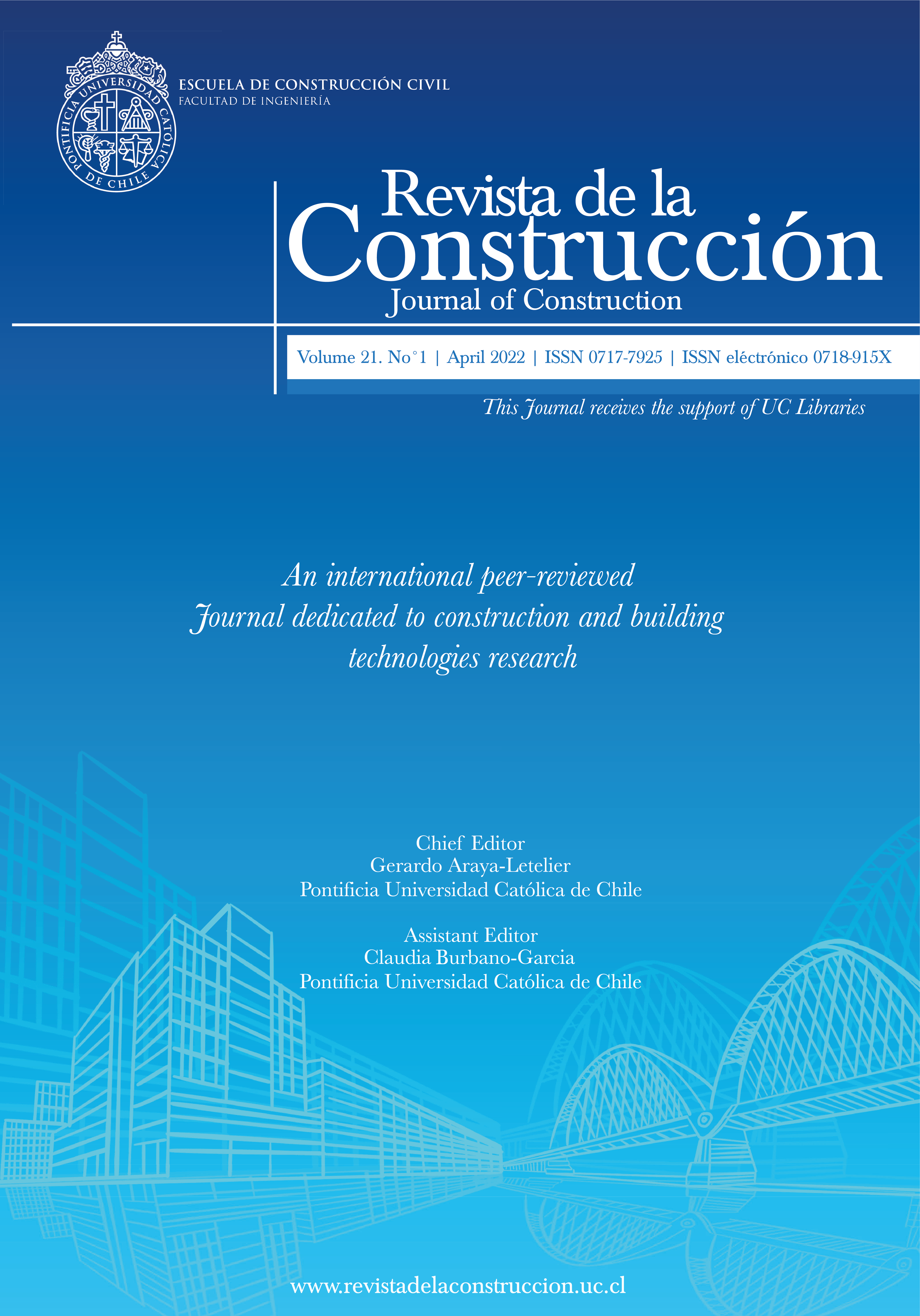Acoustic absorption prediction by placing absorbent material in separate pieces with or without back air layer
DOI:
https://doi.org/10.7764/RDLC.21.1.156Keywords:
acoustic absorption, building materials, materials in patches, sound-absorbent material, air layerAbstract
The reverberation time was tested in a reverberation chamber with three acoustic absorbent materials commonly used in construction. The tests were performed with different materials, setups, and back air layers. Results have been compared with those where this material is placed as a single piece. Analyzing obtained data, a linear regression model is established to predict, for certain frequencies, the alteration produced in the reverberation time. So, knowing the absorption coefficient of an amount of material, it is possible to predict the different absorption coefficients placing the same material in separated pieces and different distances from room walls. The model has been validated and tested, which demonstrates its accuracy, it has also been proved to be applicable to a wide variety of materials. It becomes a simple predictive tool that allows to estimate in situ the alteration in the reverberation time due to the separation of the absorbent material in patches.
References
AENOR. (1998). UNE-EN ISO 266: Acústica. Frecuencias preferentes. Retrieved December 13, 2021 from https://www.une.org/encuentra-tu-norma/busca-tu-norma/norma?c=N0013213
AENOR. (2004). UNE-EN ISO 354: Acústica. Medición de la absorción acústica en cámara reverberante. Retrieved December 13, 2021 from https://www.une.org/encuentra-tu-norma/busca-tu-norma/norma?c=N0030677
Caballol, D., & Raposo, A. P. (2016). Acoustic absorption increase prediction by placing absorbent material in pieces. Applied Acoustics, 113, 185–192. Retrieved December 13, 2021 from https://www.sciencedirect.com/science/article/pii/S0003682X16301803
Chrisler, V. L. (1934). DEPENDENCE OF SOUND ABSORPTION UPON THE AREA AND DISTRIBUTION OF THE ABSORBENT MATERIAL. Journal of Research of the National Bureau of Standards, 13, 169–187. Retrieved December 13, 2021 from
Cook, R. K. (1957). Absorption of Sound by Patches of Absorbent Materials. Journal of the Acoustical Society of America, 29(3), 324–329. Retrieved December 13, 2021 from https://doi.org/10.1121/1.1908873
Cox, T., & D’Antonio, P. (2016). Acoustic Absorbers and Diffusers: Theory, Design and Application. Acoustic Absorbers and Diffus-ers, 388–393. Retrieved December 13, 2021 from https://doi.org/10.1201/9781315369211
de Bruijn, A. (1967). Calculation of the edge effect of sound-absorbing structures. Delf. Holland. Retrieved December 13, 2021 from https://repository.tudelft.nl/islandora/object/uuid%3A0b2a9bfa-a199-434b-b0ba-e0e599d3bce5
Feshbach, H., & Harris, C. M. (1946). The Effect of Non‐Uniform Wall Distributions of Absorbing Material on the Acoustics of Rooms. The Journal of Acoustic Society of America, 18(1), 472. Retrieved December 13, 2021 from https://doi.org/10.1121/1.1902431
Garay, R. M., & Pino, N. G. (2019). Proyecto Vivienda de Emergencia, Parte 3. Revista de La Construcción. Journal of Construction, 18(1), 97. Retrieved December 13, 2021 from https://doi.org/10.7764/RDLC.18.1.96
Hanyu, T. (2010). A theoretical framework for quantitatively characterizing sound field diffusion based on scattering coefficient and absorption coefficient of walls. The Journal of the Acoustical Society of America, 128(3), 1140–1148. Retrieved December 13, 2021 from https://doi.org/10.1121/1.3463802
Hanyu, T., Hoshi, K., & Nakakita, T. (2016). Method for measuring sound scattering coefficients of walls and diffusers by using a non-diffuse sound field with unevenly-distributed sound absorption. In Proceedings of the INTER-NOISE. 45Th International Congress (pp. 1022–1030). Retrieved December 13, 2021 from
Ju Kim, Y., Sub Hwang, J., Joon Yoo, Y., Xuan Khuyen, B., Chen, X., & Lee, Y. (2017). Triple-band metamaterial absorber based on single resonator. Elsevier - Current Applied Physics, 17(10), 1260–1263. Retrieved December 13, 2021 from https://doi.org/10.1016/j.cap.2017.06.009
Kawai, Y., & Meotoiwa, H. (2005). Estimation of the area effect of sound absorbent surfaces by using a boundary integral equation. Acoustical Science and Technology, 26(2), 123–127. Retrieved December 13, 2021 from https://doi.org/10.1250/AST.26.123
Kawakami, F. (1998). Deep-well approach for canceling the edge effect in random incident absorption measurement. Journal of the Acoustical Society of Japan, 19, 327–338. Retrieved December 13, 2021 from https://www.jstage.jst.go.jp/article/ast1980/19/5/19_5_327/_article/-char/ja/
Lanoye, R., Vermeir, G., Lauriks, W., Sgard, F., & Desmet, W. (2008). Prediction of the sound field above a patchwork of absorbing materials. The Journal of the Acoustical Society of America, 123(2), 793. Retrieved December 13, 2021 from https://doi.org/10.1121/1.2823781
Ouisse, M., Ichchou, M., & Chedly, S. (2012). On the sensitivity analysis of porous material models. Journal of Sound and Vibration, 331(24), 5292–5308. Retrieved December 13, 2021 from https://doi.org/10.1016/j.jsv.2012.07.018ï
Setaki, F., Tenpierik, M., Turrin, M., & van Timmeren, A. (2014). Acoustic absorbers by additive manufacturing. Building and Environ-ment, 72, 188–200. Retrieved December 13, 2021 from https://www.sciencedirect.com/science/article/pii/S0360132313003016
Thomasson, S.-I. (1982). Theory and experiments on the sound absorption as function of the area. Stockholm: Dept. of Acoustics Royal Institute of Technology. Retrieved December 13, 2021 from
Weisberg, S. (1985). Applied Linear Regression, 2nd Ed. John Wiley & Sons, Ltd. Retrieved December 13, 2021 from https://doi.org/10.1002/BIMJ.4710300746
Downloads
Published
How to Cite
Issue
Section
License
Copyright (c) 2022 Mónica Morales-Segura, David Caballol, Álvaro P. Raposo, Francisco Gil-Carrillo

This work is licensed under a Creative Commons Attribution-NonCommercial-NoDerivatives 4.0 International License.





